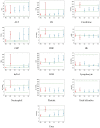Prognostic Model of COVID-19 Severity and Survival among Hospitalized Patients Using Machine Learning Techniques
- PMID: 36359571
- PMCID: PMC9689804
- DOI: 10.3390/diagnostics12112728
Prognostic Model of COVID-19 Severity and Survival among Hospitalized Patients Using Machine Learning Techniques
Abstract
We conducted a statistical study and developed a machine learning model to triage COVID-19 patients affected during the height of the COVID-19 pandemic in Hong Kong based on their medical records and test results (features) collected during their hospitalization. The correlation between the values of these features is studied against discharge status and disease severity as a preliminary step to identify those features with a more pronounced effect on the patient outcome. Once identified, they constitute the inputs of four machine learning models, Decision Tree, Random Forest, Gradient and RUSBoosting, which predict both the Mortality and Severity associated with the disease. We test the accuracy of the models when the number of input features is varied, demonstrating their stability; i.e., the models are already highly predictive when run over a core set of (6) features. We show that Random Forest and Gradient Boosting classifiers are highly accurate in predicting patients' Mortality (average accuracy ∼99%) as well as categorize patients (average accuracy ∼91%) into four distinct risk classes (Severity of COVID-19 infection). Our methodical and broad approach combines statistical insights with various machine learning models, which paves the way forward in the AI-assisted triage and prognosis of COVID-19 cases, which is potentially generalizable to other seasonal flus.
Keywords: COVID-19; machine learning; triage.
Conflict of interest statement
The authors declare they have no competing interest.
Figures





Similar articles
-
Can Predictive Modeling Tools Identify Patients at High Risk of Prolonged Opioid Use After ACL Reconstruction?Clin Orthop Relat Res. 2020 Jul;478(7):0-1618. doi: 10.1097/CORR.0000000000001251. Clin Orthop Relat Res. 2020. PMID: 32282466 Free PMC article.
-
Predicting mortality risk in patients with COVID-19 using machine learning to help medical decision-making.Smart Health (Amst). 2021 Apr;20:100178. doi: 10.1016/j.smhl.2020.100178. Epub 2021 Jan 16. Smart Health (Amst). 2021. PMID: 33521226 Free PMC article.
-
Emergency department triage prediction of clinical outcomes using machine learning models.Crit Care. 2019 Feb 22;23(1):64. doi: 10.1186/s13054-019-2351-7. Crit Care. 2019. PMID: 30795786 Free PMC article.
-
Machine Learning-Based Prediction Models for Depression Symptoms Among Chinese Healthcare Workers During the Early COVID-19 Outbreak in 2020: A Cross-Sectional Study.Front Psychiatry. 2022 Apr 29;13:876995. doi: 10.3389/fpsyt.2022.876995. eCollection 2022. Front Psychiatry. 2022. PMID: 35573334 Free PMC article.
-
A Machine Learning Approach to Predicting Need for Hospitalization for Pediatric Asthma Exacerbation at the Time of Emergency Department Triage.Acad Emerg Med. 2018 Dec;25(12):1463-1470. doi: 10.1111/acem.13655. Epub 2018 Nov 29. Acad Emerg Med. 2018. PMID: 30382605
Cited by
-
Conventional and Novel Diagnostic Tools for the Diagnosis of Emerging SARS-CoV-2 Variants.Vaccines (Basel). 2023 Feb 6;11(2):374. doi: 10.3390/vaccines11020374. Vaccines (Basel). 2023. PMID: 36851252 Free PMC article. Review.
-
Machine Learning-Based Prediction of In-Hospital Mortality in Severe COVID-19 Patients Using Hematological Markers.Can J Infect Dis Med Microbiol. 2025 May 12;2025:6606842. doi: 10.1155/cjid/6606842. eCollection 2025. Can J Infect Dis Med Microbiol. 2025. PMID: 40391097 Free PMC article.
-
Decision trees for early prediction of inadequate immune response to coronavirus infections: a pilot study on COVID-19.Front Med (Lausanne). 2023 Aug 2;10:1230733. doi: 10.3389/fmed.2023.1230733. eCollection 2023. Front Med (Lausanne). 2023. PMID: 37601789 Free PMC article.
-
A Framework for an Effective Healthy Longevity Clinic.Aging Dis. 2024 Jul 15;16(4):1971-1986. doi: 10.14336/AD.2024.0328-1. Aging Dis. 2024. PMID: 38607731 Free PMC article. Review.
References
-
- WHO Organization COVID-19 Dashboard. 2020. [(accessed on 1 April 2022)]. Available online: https://covid19.who.int/
-
- Centers for Disease Control and Prevention Symptoms of COVID-19. [(accessed on 1 April 2022)];2021 Available online: https://www.cdc.gov/coronavirus/2019-ncov/symptoms-testing/symptoms.html.
-
- Yan L., Zhang H.T., Xiao Y., Wang M., Guo Y., Sun C., Tang X., Jing L., Zhang M., Yuan Y., et al. An interpretable mortality prediction model for COVID-19 patients. Nat. Mach. Intell. 2020;2:283–288. doi: 10.1038/s42256-020-0180-7. - DOI
-
- Yan L., Zhang H.T., Xiao Y., Wang M., Sun C., Liang J., Li S., Zhang M., Guo Y., Xiao Y., et al. Prediction of criticality in patients with severe COVID-19 infection using three clinical features: A machine learning-based prognostic model with clinical data in Wuhan. medRxiv. 2020 doi: 10.1101/2020.02.27.20028027. - DOI
Grants and funding
LinkOut - more resources
Full Text Sources

